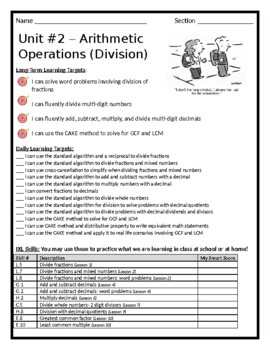Division and Decimals Unit Packet (Number System Standards)
166 Downloads
Tresa Westcott
80 Followers
Resource Type
Standards
CCSS6.NS.A.1
CCSS6.NS.B.2
CCSS6.NS.B.3
CCSS6.NS.B.4
Formats Included
- Word Document File
Pages
36 pages
Tresa Westcott
80 Followers
Description
Comprehensive fractions unit aligned to the Next Generation Math standards (6th grade). Includes lessons on dividing fractions and mixed numbers, division algorithms, dividing whole numbers and decimals, adding, subtracting, multiplying and dividing decimals, GCF and LCM. Each lesson includes learning targets, guided notes, example problems, guided practice, and classwork problems. Each lesson is also aligned to IXL skills for extra practice. Answer key available as separate purchase.
Total Pages
36 pages
Answer Key
Not Included
Teaching Duration
2 Weeks
Last updated Jul 29th, 2021
Report this resource to TPT
Reported resources will be reviewed by our team. Report this resource to let us know if this resource violates TPT’s content guidelines.
Standards
to see state-specific standards (only available in the US).
CCSS6.NS.A.1
Interpret and compute quotients of fractions, and solve word problems involving division of fractions by fractions, e.g., by using visual fraction models and equations to represent the problem. For example, create a story context for (2/3) ÷ (3/4) and use a visual fraction model to show the quotient; use the relationship between multiplication and division to explain that (2/3) ÷ (3/4) = 8/9 because 3/4 of 8/9 is 2/3. (In general, (𝘢/𝘣) ÷ (𝘤/𝘥) = 𝘢𝘥/𝘣𝘤.) How much chocolate will each person get if 3 people share 1/2 lb of chocolate equally? How many 3/4-cup servings are in 2/3 of a cup of yogurt? How wide is a rectangular strip of land with length 3/4 mi and area 1/2 square mi?
CCSS6.NS.B.2
Fluently divide multi-digit numbers using the standard algorithm.
CCSS6.NS.B.3
Fluently add, subtract, multiply, and divide multi-digit decimals using the standard algorithm for each operation.
CCSS6.NS.B.4
Find the greatest common factor of two whole numbers less than or equal to 100 and the least common multiple of two whole numbers less than or equal to 12. Use the distributive property to express a sum of two whole numbers 1–100 with a common factor as a multiple of a sum of two whole numbers with no common factor. For example, express 36 + 8 as 4 (9 + 2).





